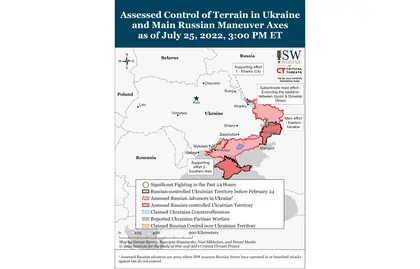Key Takeaways
- Russian forces made marginal gains south of Bakhmut but are unlikely to be able to effectively leverage these advances to take full control of Bakhmut itself.
- Russian forces conducted limited ground attacks north of Kharkiv City, east of Siversk, and east of Bakhmut.
- Russian forces are continuing to fortify and strengthen positions in Zaporizhia and Kherson Oblasts in anticipation of Ukrainian counteroffensives.
- Ukrainian forces are continuing to strike Russian strongholds along the Southern Axis.
- Russian forces continued to withdraw military equipment from storage in Omsk and face challenges with repairing damaged combat vehicles.
- Russian occupation officials are continuing to set conditions for the annexation of occupied territories to the Russian Federation and to extend administrative control of occupied areas of Ukraine.
Russian forces made marginal territorial gains south of Bakhmut on July 25 but are largely suffering from the same fundamental limitations that previously prevented them from rapidly gaining substantial ground during offensive operations in Luhansk Oblast. Geolocated social media footage from July 25 shows that troops of the Wagner Group Private Military Company (PMC) have advanced into Novoluhanske and Russian and Ukrainian sources noted that Russian forces are taking control of the territory of the Vuhledar Power Plant on the northern edge of Novoluhanske, likely as a result of a controlled Ukrainian withdrawal from the area.
JOIN US ON TELEGRAM
Follow our coverage of the war on the @Kyivpost_official.
Russian Telegram channels began reporting on Russian attempts to advance on Novoluhanske as early as May 25, which means that Russian troops have been unsuccessfully attacking this single location for two months. Novoluhanske is neither a large settlement nor is it characterized by particularly challenging terrain, yet Russian forces have impaled themselves on it for weeks.
The capture of Novoluhanske and the Vuhledar Power Plant will not generate an advantageous salient along which Russian troops will be able to advance northwards towards Bakhmut. The Russian campaign to seize the Severodonetsk-Lysychansk area benefitted from the fact that they had already created a salient with those two cities near its apex. They were able continually to press on the flanks of Ukrainian defensive positions until they had secured Severodonetsk. They struggled after that to take advantage of the fact that Lysychansk remained at the apex of a salient until they managed to break out from Popasna to the south and drive northward. Siversk is currently the town closest to the apex of the remaining salient, and Russian forces have struggled to advance against it. The Russian seizure of Novoluhanske and the Vuhledar Power Plant, on the other hand, flattens the Ukrainian defensive line rather than perpetuating a salient, thereby limiting the advantage the occupation of those areas gives to the Russian forces.

EU Transfers €1.5 Bln Raised From Russian Assets for Ukraine
The operations around Novoluhanske indicate that Russian forces are suffering the same limitations in terms of their ability to effectively use battlefield geometry (such as the creation of effective salients) to their advantage, which is exacerbated by the extreme difficulty Russian forces regularly have capturing small and relatively insignificant bits of terrain over weeks or months of fighting. These limitations will grow as Russian units continually degrade themselves during assaults on small villages. Russian forces are unlikely to be able to effectively leverage the capture of Novoluhanske to take Bakhmut, and the continual tactical and operational limitations they are facing on the battlefield will likely contribute to the culmination of the offensive in Donbas before capturing Bakhmut, Slovyansk, or any other major city in Donetsk Oblast.
Authors: Karolina Hird, Kateryna Stepanenko, Katherine Lawlor, Layne Philipson, and Frederick W. Kagan
See the full report here.
You can also highlight the text and press Ctrl + Enter






